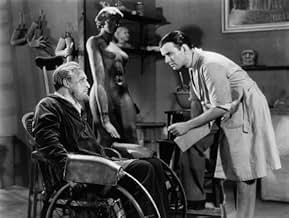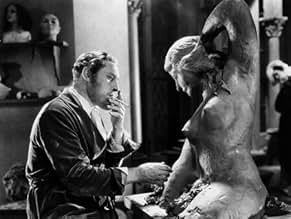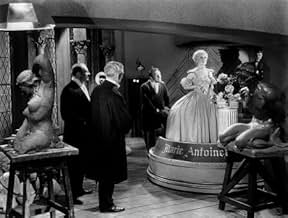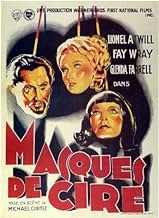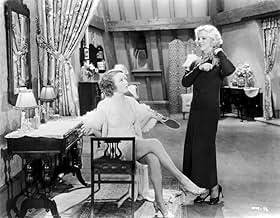VALUTAZIONE IMDb
6,8/10
7228
LA TUA VALUTAZIONE
Aggiungi una trama nella tua linguaThe disappearance of people and corpses leads a reporter to a wax museum and a sinister sculptor.The disappearance of people and corpses leads a reporter to a wax museum and a sinister sculptor.The disappearance of people and corpses leads a reporter to a wax museum and a sinister sculptor.
- Regia
- Sceneggiatura
- Star
Thomas E. Jackson
- Detective
- (as Thomas Jackson)
Bull Anderson
- Janitor
- (non citato nei titoli originali)
Frank Austin
- Winton's Valet
- (non citato nei titoli originali)
Max Barwyn
- Museum Visitor
- (non citato nei titoli originali)
Wade Boteler
- Ambrose
- (non citato nei titoli originali)
Recensioni in evidenza
Michael Curtiz has over 170 directing credits, including "The Jazz Singer." Of the films on that list which I have seen, this is my favourite. It's filled with some quite amazing dolly and camera work, the story is fun and the acting is solid.
This story has had a long life. This film, was based on a play. In 1953, it was re-made as a Vincent Price vehicle, "House of Wax" in 3-D. And in 2005, it was re-made again as a teen slasher. The premise is solidly creepy.
Glenda Farrell is hilarious as the young journalist. Her energy leaps off the screen. I guess audiences of 1933 needed quite a bit of comic relief to make it through the rest of this.
Lionel Atwill's make-up is fantastic. It's no surprise that it was designed by a Westmore: Hollywood's premiere make-up family.
This was shot in a two-colour Technicolor process which makes the entire film rather distinctive and moody. The fantastic film noir lighting adds to it as well.
If you can find this, it's a definite must-see! There are so many images and ideas borrowed from it in later horror films it's interesting to see their origins.
This story has had a long life. This film, was based on a play. In 1953, it was re-made as a Vincent Price vehicle, "House of Wax" in 3-D. And in 2005, it was re-made again as a teen slasher. The premise is solidly creepy.
Glenda Farrell is hilarious as the young journalist. Her energy leaps off the screen. I guess audiences of 1933 needed quite a bit of comic relief to make it through the rest of this.
Lionel Atwill's make-up is fantastic. It's no surprise that it was designed by a Westmore: Hollywood's premiere make-up family.
This was shot in a two-colour Technicolor process which makes the entire film rather distinctive and moody. The fantastic film noir lighting adds to it as well.
If you can find this, it's a definite must-see! There are so many images and ideas borrowed from it in later horror films it's interesting to see their origins.
Considering the fact that this 1933 movie was produced during the depression, when moviegoers expected pure entertainment, the results were exactly what they wanted. Glenda Farrell's hard-boiled Florence Dempsey was what filmgoers were looking for. Please note that many of the movies of the period had male and female stars who were fast talkers and wise-crackers. Such stars as Cary Grant, Carole Lombard, Rosalind Russell, Bette Davis, James Cagney, Mae West, W. C. Fields, William Powell, Myrna Loy, etc. were the norm and not the exception.
This wonderful movie was way ahead of its time. It's two-color look was also something very different for the 1930s and its washed-out looked helped give it a more sinister appearance. The later "House of Wax" used 3-D and having seen it in the movies I can tell you it was probably the best of the 3-D movies. Even better than "The Creature from the Black Lagoon".
Fay Wray was pure candy and she practiced her scream well for the upcoming "King Kong". I have seen most of Lionel Atwill's work and I believe the underplaying of Ivan Igor helped make him a more credible monster. The movie was well cast and one can not help but notice the uncanny fact that most of the actors in "The House of Wax" were chosen because they looked like the earlier actors except for the difference between Charles Buchinsky (Bronson) and Matthew Betz as the loyal mute assistant.
Although enjoyable, "The House of Wax" was no match for the earlier edition. It's understandable that "The House of Wax" did not use the characters of Florence Dempsey and Gavin Gordon. Sidekicks didn't work as well as in the 50s.
I wonder what the movie critics of the 30s thought of the "Mystery of the Wax Museum?"
This wonderful movie was way ahead of its time. It's two-color look was also something very different for the 1930s and its washed-out looked helped give it a more sinister appearance. The later "House of Wax" used 3-D and having seen it in the movies I can tell you it was probably the best of the 3-D movies. Even better than "The Creature from the Black Lagoon".
Fay Wray was pure candy and she practiced her scream well for the upcoming "King Kong". I have seen most of Lionel Atwill's work and I believe the underplaying of Ivan Igor helped make him a more credible monster. The movie was well cast and one can not help but notice the uncanny fact that most of the actors in "The House of Wax" were chosen because they looked like the earlier actors except for the difference between Charles Buchinsky (Bronson) and Matthew Betz as the loyal mute assistant.
Although enjoyable, "The House of Wax" was no match for the earlier edition. It's understandable that "The House of Wax" did not use the characters of Florence Dempsey and Gavin Gordon. Sidekicks didn't work as well as in the 50s.
I wonder what the movie critics of the 30s thought of the "Mystery of the Wax Museum?"
A genuinely frightening film from Michael Curtiz, jack of no trades and master of all. Many of the tricks of classic 1930's horror are here, including the opening scene set in a dark, rainy London street, the long shadows on the wall, lengthy periods of silence, and all timed to perfection. Only the faster-than-the-speed-of-sound dialogue of Glenda Farrell truly lets the film down. But other than that it is a gothic masterpiece, an underrated movie probably due to the fact that it lay undiscovered, thought lost, for over half a century. Far more inventive and imaginative than the majority of horror films made today.
In the early 30s, Hungarian director Michael Curtiz was still considered a recently arrived foreigner working at Warner Bros. after impressing legendary producer Jack Warner with his work in Germany. In those early days of his career in the U.S. Curtiz began to make himself a name as a hard working director who always managed to work effectively under the studio system, and it was with the success of the horror films, "The Mad Genius" and "Doctor X", when he proved to be not only effective, but also able to make box-office hits. It was really the success of "Doctor X" what prompted Warner Brothers to make another horror movie in the same style, with the same same cast, and keeping Michael Curtiz as director. The result was the now classic Technicolor thriller, "Mystery of the Wax Museum".
Ivan Igor (Lionel Atwill) is an extremely talented sculptor of wax figures in London, however, his employer thinks that Igor's business i snot making enough money for both of them, and starts a fire at Igor's Wax Museum in order to collect the insurance money. Thirteen years later, Ivan Igor is tragically crippled and unable to use his hands, but with the help of his students he is finally ready to reopen his museum in New York City. In the meantime, the police is baffled by the case of several corpses stolen from the City's morgue, including the one of a famous socialité. The case attracts the attention of Florence Dempsey (Glenda Farrell), a young reporter looking for her big story, and immediately she starts to investigate. Her suspicion will lead her to important clues, and Igor's strange obsession with Florence's roommate Charlotte (Fay Wray) will take her to uncover the strange mystery of the Wax Museum.
The key word in "Mystery of the Wax Museum" is "Mystery", as unlike it's better known 1953 remake (which focuses on horror and suspense), this version of Charles Belden's play behaves more like a simple, yet really captivating, tale of mystery where our main character, Florence, must discover who and more importantly "how" is committing the crimes. Adapted by Don Mullaly and Carl Erickson, the movie has a very original plot that unfolds nicely despite the fast pace of the film. The fact that it was written before the days of the Hays code allows the film to include lots of sexual innuendo and situations that later would be considered immoral. The characters are overall very well developed, and the addition of comedy (courtesy of Farrell's wisecracking character) works nicely with the creepy mystery of the story.
On of the lasts movies to be shot in the primitive two-color Technicolor system, it has a marvelous bleached look that works perfectly with the modernist art-deco style of the sets designed for the film. Director Michael Curtiz allows himself to show the influence he received when working in Germany during the years of expressionism, and gives the film an ominous dark look as Florence gets deeper inside the Wax Museum (although not as striking as what Universal Studios did with its horror films). It's worth to point out that while Curtiz may be better known as an effective director for hire under the studio system, he really shows a definite style in this film, and begins to give form to the elements that would later become part of his masterpiece, "Casablanca".
The cast is overall excellent, although it is of course difficult not to make comparisons with the performances of the better known 50s version. Lionel Atwill offers one of his most underrated performances of his career as Ivan Igor, and while he lacks the charm that Vincent Price would give to the role, he is very believable as the tortured artist, victim of misfortune. Glenda Farrell's turn as Florence Dempsey has been harshly criticized due to the comic nature of her character's persona, but honestly she makes a terrific job as the main character, vastly overshadowing the more famous Fay Wray; who while looking stunningly beautiful here, lacks the presence that would make her an icon in "King Kong".
While "House of Wax" tends to get the upper hand when compared to the original version, "Mystery" is by no means a bad movie, simply a different one. As written above, this movie focuses completely on the mystery aspect of the story, and while it does have its fair share of horrific elements, they are minimal when compared with the Gothic horror of "House of Wax". True, it certainly looks dated by today's standards, but the movie has a notorious modernist (in the architecture, designs, etc...) touch that may have looked futurist for the 30s society. The special effects are definitely less impressive than in the remake, but considering the times when they were done are still an excellent work, and some look really impressive thanks to the lavish Technicolor process.
Personally, I find in "House" and "Mystery" a classic example of what a remake should be, as the two are excellent movies that explore the same story under different angles. Fans tend to dismiss "Mystery", but I think it's equally as good as the legendary Vincent Price film. "Mystery of the Wax Museum" is a very interesting movie for fans of "House of Wax", and a definitive must-see for those interested in horror movies of the 30s. 8/10
Ivan Igor (Lionel Atwill) is an extremely talented sculptor of wax figures in London, however, his employer thinks that Igor's business i snot making enough money for both of them, and starts a fire at Igor's Wax Museum in order to collect the insurance money. Thirteen years later, Ivan Igor is tragically crippled and unable to use his hands, but with the help of his students he is finally ready to reopen his museum in New York City. In the meantime, the police is baffled by the case of several corpses stolen from the City's morgue, including the one of a famous socialité. The case attracts the attention of Florence Dempsey (Glenda Farrell), a young reporter looking for her big story, and immediately she starts to investigate. Her suspicion will lead her to important clues, and Igor's strange obsession with Florence's roommate Charlotte (Fay Wray) will take her to uncover the strange mystery of the Wax Museum.
The key word in "Mystery of the Wax Museum" is "Mystery", as unlike it's better known 1953 remake (which focuses on horror and suspense), this version of Charles Belden's play behaves more like a simple, yet really captivating, tale of mystery where our main character, Florence, must discover who and more importantly "how" is committing the crimes. Adapted by Don Mullaly and Carl Erickson, the movie has a very original plot that unfolds nicely despite the fast pace of the film. The fact that it was written before the days of the Hays code allows the film to include lots of sexual innuendo and situations that later would be considered immoral. The characters are overall very well developed, and the addition of comedy (courtesy of Farrell's wisecracking character) works nicely with the creepy mystery of the story.
On of the lasts movies to be shot in the primitive two-color Technicolor system, it has a marvelous bleached look that works perfectly with the modernist art-deco style of the sets designed for the film. Director Michael Curtiz allows himself to show the influence he received when working in Germany during the years of expressionism, and gives the film an ominous dark look as Florence gets deeper inside the Wax Museum (although not as striking as what Universal Studios did with its horror films). It's worth to point out that while Curtiz may be better known as an effective director for hire under the studio system, he really shows a definite style in this film, and begins to give form to the elements that would later become part of his masterpiece, "Casablanca".
The cast is overall excellent, although it is of course difficult not to make comparisons with the performances of the better known 50s version. Lionel Atwill offers one of his most underrated performances of his career as Ivan Igor, and while he lacks the charm that Vincent Price would give to the role, he is very believable as the tortured artist, victim of misfortune. Glenda Farrell's turn as Florence Dempsey has been harshly criticized due to the comic nature of her character's persona, but honestly she makes a terrific job as the main character, vastly overshadowing the more famous Fay Wray; who while looking stunningly beautiful here, lacks the presence that would make her an icon in "King Kong".
While "House of Wax" tends to get the upper hand when compared to the original version, "Mystery" is by no means a bad movie, simply a different one. As written above, this movie focuses completely on the mystery aspect of the story, and while it does have its fair share of horrific elements, they are minimal when compared with the Gothic horror of "House of Wax". True, it certainly looks dated by today's standards, but the movie has a notorious modernist (in the architecture, designs, etc...) touch that may have looked futurist for the 30s society. The special effects are definitely less impressive than in the remake, but considering the times when they were done are still an excellent work, and some look really impressive thanks to the lavish Technicolor process.
Personally, I find in "House" and "Mystery" a classic example of what a remake should be, as the two are excellent movies that explore the same story under different angles. Fans tend to dismiss "Mystery", but I think it's equally as good as the legendary Vincent Price film. "Mystery of the Wax Museum" is a very interesting movie for fans of "House of Wax", and a definitive must-see for those interested in horror movies of the 30s. 8/10
She has been so sorely maligned. Despite what has been claimed by others here, Glenda Farrell was not a bad actress. A little broad sometimes perhaps, but not bad. She is a dynamo of live energy, which the film badly needs, for the only other energetic character in the film is Atwill, and only Farrell has the force to bring him down(that the script does not let her do so personally betrays the character). It is not Farrell's performance or even her character which is the problem of the film, but the script which makes that character necessary. Chock Full O' undeveloped characters (only Atwill and Farrell qualify as more than ciphers)whose paths cross coincidentally,Farrell's reporter is the one in the middle bringing the disparate elements together. A reporter or policeman had to be the central character, for only one of those two would be privy to all or even enough of the info needed to solve the puzzle, or to even recognize that the puzzle existed. And only a female reporter could be Fay Wray's roommate, as female police detectives or beat cops didn't exist(at least not in Hollywood). And only a fast-talking, wisecracking, brash and fierce female reporter able to beat the stereotypical fast-talking, wisecracking, brash 1930's male reporter at his own game could find the story AND crack the case before the police. Others have objected to the attention given the comic relief, apparently misunderstanding the term. Comic relief characters are supporting characters, and in this film, despite third billing, Glenda Farrell is the female lead. Fay Wray was a freelancer and able to negotiate better billing even though her role doesn't deserve it. Had she not had a real lead in the companion film DR.X, it's unlikely she would have been asked to take such a small part. Charlotte is needed in the story only for a face, and her face and scream are all Wray is allowed to bring to the role. As outstanding as those two attributes are, they don't add up to a real character. And while Farrell cracks wise, she is doing serious work central to the tale. A role with comedic content is not automatically a comic relief part. The script is a mess, letting down the great concept. HOUSE OF WAX is a much tighter script, more linear, combining ingenue and snoop into one role, and beefing up the part of the disfigured sculptor. It drops the very extraneous playboy character and the loose ends which trail in his wake. But most agree that HOUSE is boring compared to MYSTERY, and in addition to the direction and editing, much of MYSTERY's drive comes from the girl reporter and the crack actress who played her. Even if you do find her grating, Glenda Farrell is never boring.
Lo sapevi?
- QuizThis film was produced before the Production Code. When it was remade 20 years later, as La maschera di cera (1953), all references to drug use were removed, and a character was changed from a junkie to an alcoholic.
- BlooperIvan Igor says that Jean Paul Marat's assassin, Charlotte Corday, was his mistress. This is incorrect; they never had met until she came to his office posing as a courier and quickly stabbed him to death. After her execution a few days later, she was found to be virgo intacta.
- Versioni alternativeThis film was shot in two versions. One camera unit shot the film in two-color Technicolor. A second camera unit shot the scenes at the same time in black and white. The black and white version was meant for theaters who could not afford the higher rental cost of the color prints.
- ConnessioniEdited into Mame (1974)
I più visti
Accedi per valutare e creare un elenco di titoli salvati per ottenere consigli personalizzati
Dettagli
- Data di uscita
- Paese di origine
- Lingua
- Celebre anche come
- Mystery of the Wax Museum
- Luoghi delle riprese
- Azienda produttrice
- Vedi altri crediti dell’azienda su IMDbPro
- Tempo di esecuzione1 ora 17 minuti
- Proporzioni
- 1.37 : 1
Contribuisci a questa pagina
Suggerisci una modifica o aggiungi i contenuti mancanti

Divario superiore
By what name was La maschera di cera (1933) officially released in India in English?
Rispondi

